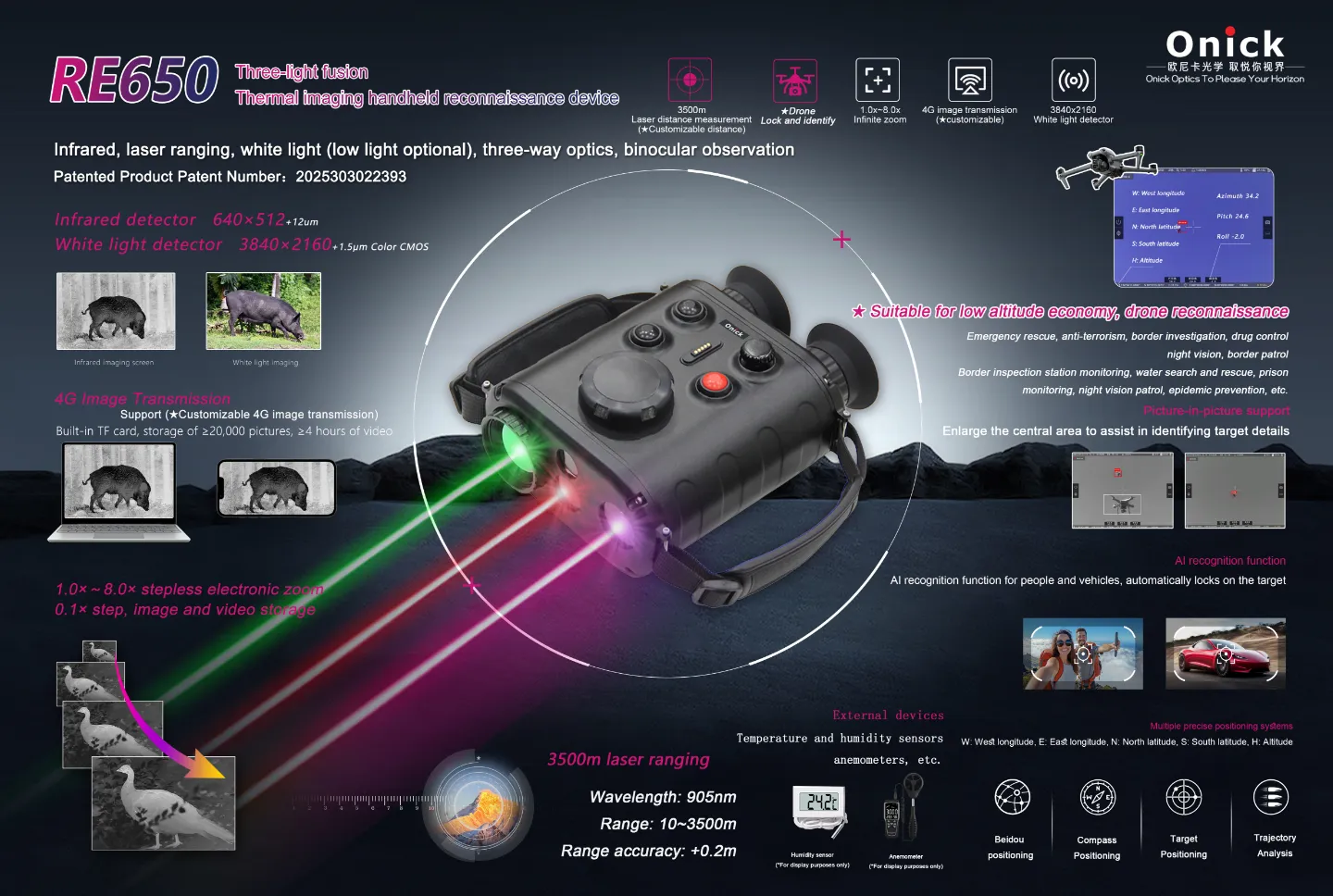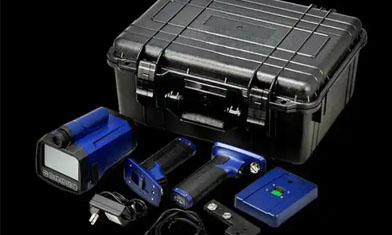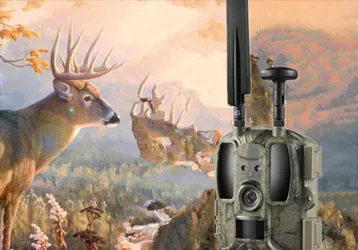Máy Dò Sự Sống Hình Ảnh Nhiệt Hồng Ngoại, Phát Hiện Và Xác Định Vị Trí Những Người Sống Sót Trong Tàn Tích
Máy dò cuộc sống hình ảnh nhiệt ba ánh sáng cầm tay RE650 sử dụng các đặc tính nhiệt độ không đổi của cơ thể con người để chụp bức xạ hồng ngoại thông qua một máy dò độ nhạy cao, chuyển đổi nó thành hình ảnh nhiệt rõ ràng, không bị ảnh hưởng bởi ánh sáng và khói, và có thể nhanh chóng xác định vị trí những người sống sót trong đống đổ nát.

Onick RE650 là một thiết bị quan sát và trinh sát hình ảnh nhiệt ba ánh sáng cầm tay được trang bị máy ảnh TV, máy ảnh nhiệt hồng ngoại không được làm mát, máy đo khoảng cách laser, GPS, la bàn điện tử và các chức năng khác. Nó có thể được sử dụng để trinh sát ngày và đêm trong mọi thời tiết, định vị mục tiêu, v.v. Sản phẩm có hiệu ứng hình ảnh hồng ngoại tốt, nhỏ và nhẹ, tiêu thụ điện năng thấp, điều khiển đơn giản, ngoại hình nhẹ và di động, và có độ bám tốt. Sản phẩm sử dụng cảm biến hồng ngoại độ phân giải cao, có hiệu ứng hình ảnh hồng ngoại tốt, tiêu thụ điện năng cực thấp, khởi động nhanh, điều khiển đơn giản, cấu trúc nhỏ gọn và ổn định.
Chức năng chính:
1. hồng ngoại, hình ảnh ánh sáng trắng, quan sát hai mắt, lưu trữ hình ảnh và video;
2. Zoom điện tử 1.0 ~ 8.0 zoom vô cấp, bước 0.1;
3. Phạm vi laser, định vị Beidou, định hướng la bàn, định vị mục tiêu, chức năng tính toán quỹ đạo;
4. Giao diện mở rộng dành riêng, có thể được kết nối với cảm biến độ ẩm, máy đo gió, v.v.;
5. Với độ xuyên sương mù, góc cuộn, góc cao độ, cảm biến áp suất không khí, chức năng chẩn đoán lỗi;
6. Chức năng nhận dạng AI của mục tiêu con người và phương tiện; khóa và xác định máy bay không người lái;
Application field
Applicable nền kinh tế tầm thấp, cứu hộ khẩn cấp, chống khủng bố, trinh sát, phòng thủ biên giới, kiểm soát ma túy tầm nhìn ban đêm, tuần tra biên giới, giám sát trạm kiểm tra biên giới, tìm kiếm và cứu nạn nước, giám sát nhà tù, tuần tra tầm nhìn ban đêm, phòng chống dịch bệnh, v.v.

2The nguyên tắc làm việc của máy dò cuộc sống hình ảnh nhiệt ba ánh sáng cầm tay RE650 dựa trên đặc tính vật lý mà tất cả các vật thể trong tự nhiên phát ra tia hồng ngoại. Là một sinh vật máu nóng, cơ thể con người sẽ liên tục phát ra các tia hồng ngoại có bước sóng cụ thể đến môi trường xung quanh và cường độ bức xạ khác biệt đáng kể so với các vật thể môi trường. Thiết bị nhận các tín hiệu bức xạ hồng ngoại này thông qua một máy dò hồng ngoại có độ nhạy cao, và sau khi chuyển đổi quang điện và xử lý kỹ thuật số. Trong hình ảnh, cơ thể con người thể hiện một khu vực nhiệt độ cao hoàn toàn khác với môi trường nhiệt độ thấp xung quanh do sinh nhiệt liên tục. Lực lượng cứu hộ có thể nhanh chóng tìm ra vị trí của những người sống sót bằng cách xác định chênh lệch nhiệt độ này.
Các công nghệ cốt lõi của thiết bị bao gồm hệ thống quang học hồng ngoại, cụm máy dò và mô-đun xử lý hình ảnh. Hệ thống quang học hồng ngoại chịu trách nhiệm thu thập bức xạ hồng ngoại trong khu vực mục tiêu để đảm bảo các tín hiệu yếu có thể được tập trung hiệu quả; cụm máy dò chuyển đổi tín hiệu hồng ngoại thành tín hiệu điện và độ nhạy xác định trực tiếp khả năng phát hiện của các nguồn nhiệt xa hoặc yếu; mô-đun xử lý hình ảnh thực hiện giảm và tăng cường tiếng ồn trên tín hiệu gốc để làm cho hình ảnh nhiệt rõ ràng hơn, thuận tiện cho người cứu hộ đưa ra phán đoán chính xác.
Nó không bị giới hạn bởi điều kiện ánh sáng và có thể hoạt Nó có khả năng thâm nhập mạnh mẽ đối với khói, bụi và các vật cản khác, và có thể phát hiện các điều kiện bên trong thông qua các khoảng trống trong đống đổ nát. Thiết bị này rất dễ vận hành và lực lượng cứu hộ có thể nhanh chóng quét khu vực mục tiêu bằng cách giữ nó hoặc thiết lập nó và tạo ra hình ảnh nhiệt trong thời gian thực. Thông qua quét liên tục và phân tích hình ảnh, vị trí gần đúng và số lượng người sống sót có thể được xác định.





















